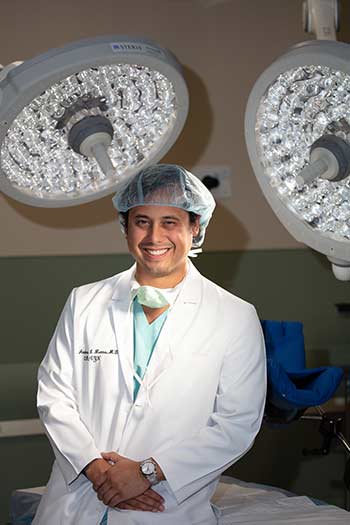What is benign gynecological surgery?
Women's Care
With robotic surgical technology patients can heal quicker and get home sooner
It’s the present and the future of surgery – minimally-invasive laparoscopic and robotic procedures that have patients home sooner and healed more quickly.
At St. Joseph’s/Candler, we have the latest robotic technology in the da Vinci Robotic Surgical System. By providing surgeons with high-definition visualization and precision replication of the surgeon’s movements, the da Vinci Surgical System makes it possible for surgeons to perform complex procedures using minimally-invasive techniques, resulting in numerous potential patient benefits.
If you have a non-cancerous (benign) reproductive condition that requires surgery, your physician may recommend surgery. That can be open surgery or minimally-invasive laparoscopic or robotically with the da Vinci robot. Today, surgical gynecologists are choosing to do more surgeries robotically.

“I am able to see things magnified much more than the naked eye,” says Dr. Andres Montes, an OB/GYN with St. Joseph’s/Candler. “With the instruments themselves, I am able to have more mobility than my own hands.”
About da Vinci Xi
The da Vinci robot uses sophisticated computer-aided equipment which allows the surgeon to have the benefit of magnified views of regular laparoscopic surgery while retaining the three-dimensional view of traditional open surgery, all in high definition. This enhanced view allows the surgeon to see structures and problem tissues that might not otherwise be seen.
The surgeon sits at a console where their hands are placed into glove-like controllers, called masters, which are used to manipulate the robotic surgical EndoWrist instruments. The on-board computer replicates the surgeon’s movements precisely and to scale while filtering out the surgeon’s pulse, called tremor, normally seen at high magnification. This allows the surgeon to move in a more natural fashion.
At St. Joseph’s/Candler, a number of surgeons are trained on the da Vinci Surgical System, performing a variety of surgeries. Robotic surgery is used for bowel resections, hernia repairs, gallbladder removal, tumor removal and lymph node dissections, among others.
It’s Dr. Montes’ preferred way to perform benign gynecological procedures.
“What I love about it is I am able to treat people who in the past required very open incisions compared to now very small incisions,” Dr. Montes says.
For example, robotic surgery is great for a patient who has diabetes because they often have decreased wound healing, which could make recovery following an open surgery prolonged. It’s also ideal for a patient on blood thinners because there’s much less blood loss.
The benefits to the patient having a robotic or laparoscopic procedure versus an open procedure include:
- Less pain
- Shorter hospital stay (typically one night vs. three)
- Less blood loss and potential for transfusions
- Quicker recovery and return to normal daily activities
“As far as pain goes, it’s shown to have less pain post-op,” Dr. Montes says. “A lot of my patients are about 95 percent themselves after about two weeks. In an open surgery, it takes six-weeks for full recovery.”
Not everyone is a candidate for robotic surgery. For example, if the size of your uterus is too large, open surgery will be required. Those cases are rare, however, as Dr. Montes says he does about one open surgery every few months. In the past year, he’s done nearly 90 robotic benign gynecological surgeries.
If your physician recommends a benign gynecological surgery you will discuss the best option for you.
In need of an OB/GYN in the Savannah area? Find one here.